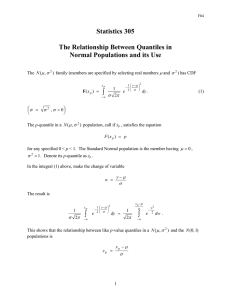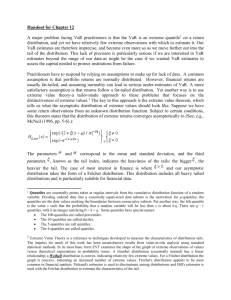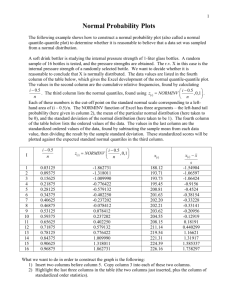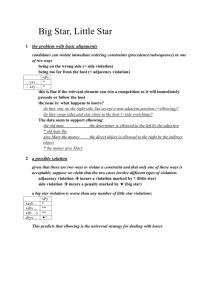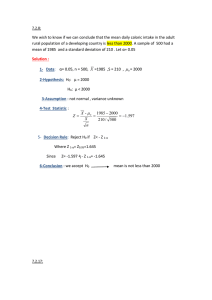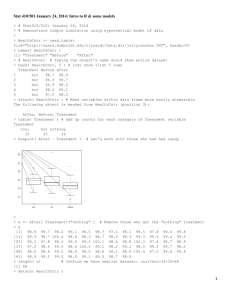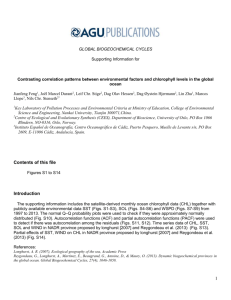Homework #5, Solution, posted 15 Feb 2013
advertisement
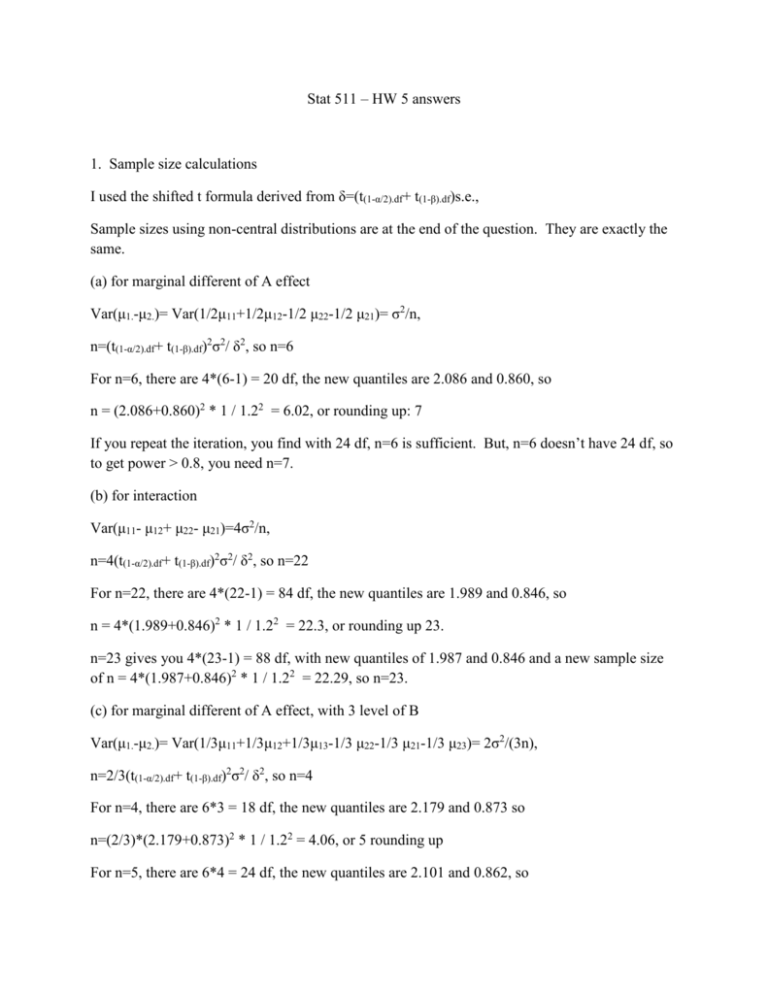
Stat 511 – HW 5 answers
1. Sample size calculations
I used the shifted t formula derived from δ=(t(1-α/2).df+ t(1-β).df)s.e.,
Sample sizes using non-central distributions are at the end of the question. They are exactly the
same.
(a) for marginal different of A effect
Var(μ1.-μ2.)= Var(1/2μ11+1/2μ12-1/2 μ22-1/2 μ21)= σ2/n,
n=(t(1-α/2).df+ t(1-β).df)2σ2/ δ2, so n=6
For n=6, there are 4*(6-1) = 20 df, the new quantiles are 2.086 and 0.860, so
n = (2.086+0.860)2 * 1 / 1.22 = 6.02, or rounding up: 7
If you repeat the iteration, you find with 24 df, n=6 is sufficient. But, n=6 doesn’t have 24 df, so
to get power > 0.8, you need n=7.
(b) for interaction
Var(μ11- μ12+ μ22- μ21)=4σ2/n,
n=4(t(1-α/2).df+ t(1-β).df)2σ2/ δ2, so n=22
For n=22, there are 4*(22-1) = 84 df, the new quantiles are 1.989 and 0.846, so
n = 4*(1.989+0.846)2 * 1 / 1.22 = 22.3, or rounding up 23.
n=23 gives you 4*(23-1) = 88 df, with new quantiles of 1.987 and 0.846 and a new sample size
of n = 4*(1.987+0.846)2 * 1 / 1.22 = 22.29, so n=23.
(c) for marginal different of A effect, with 3 level of B
Var(μ1.-μ2.)= Var(1/3μ11+1/3μ12+1/3μ13-1/3 μ22-1/3 μ21-1/3 μ23)= 2σ2/(3n),
n=2/3(t(1-α/2).df+ t(1-β).df)2σ2/ δ2, so n=4
For n=4, there are 6*3 = 18 df, the new quantiles are 2.179 and 0.873 so
n=(2/3)*(2.179+0.873)2 * 1 / 1.22 = 4.06, or 5 rounding up
For n=5, there are 6*4 = 24 df, the new quantiles are 2.101 and 0.862, so
n==(2/3)*(2.100+0.862)2 * 1 / 1.22 = 3.94, or 4 rounding up.
By the same principle as in a), you need n=5.
If you used software (e.g. SAS proc power) that uses non-central distributions, or worked
directly with the non-central probability functions, you get exactly the same answers: 7, 23 and
5.
(d) total df increases, observation number for marginal A effect increase, and variance decreases
2. By Spectral Decomposition Theorem, when V is positive definite symmetric matrix, we have
V=UDU’, where D is diagonal matrix with positive eigenvalues, and U’U=I
So Vk= UDkU’, for k=1/2,-1and -1/2, we have
(Vk)’= (UDkU’)’= U(Dk)’U’= UDkU’, since Dk is diagonal matrix.
3. Alpine plants in multiple experiments
(a)Anova Table
source
df
Species
1
Habitats
2
Experiments
1
Habitat*Experiments
2
Species* Habitats
2
Species* Experiments
1
Species* Habitats* Experiments
2
Error
108
Total
119
(b) The F-test associated with species*experiment
The F-test associated with 3-way interaction
(C) Test of main effects of site difference in two experiments, which is site*experiment effect,
F=0.39 p=0.68
Test of site and species interaction effect difference in two experiments, which is 3-way
interaction, F=0.29 p= 0.75
Note: I was inconsistent between parts B and C. If you answered the part B question:
species*experiment: F = 0.56, p = 0.46 instead of site*experiment, that was accepted with full
credit.
Note: You need to use type III SS because the sample sizes are not equal.
4. Fractional factorials
(a) No, x2 is not confounded with other effects in the design matrix
x2 is confounded with x1*x3*x4*x5
The values in the x2 column are exactly the same as the values that result from
multiplying x1*x3*x4*x5.
Note: to see why this leads to confounding, consider a model with only those two
columns and an intercept:
𝐸 𝑌 = 𝛽0 + 𝛽2 𝑋2 + 𝛽1345 𝑋1345 = 𝛽0 + 𝛽2 𝑋2 + 𝛽1345 𝑋2 = 𝛽0 + (𝛽2 + 𝛽1345 )𝑋2
(b) x2*x3 is confounded with x1*x4*x5
(c) x3: 2.81, x4 : -2.08 x35 : 7.62
Note: x3 and x4 are twice the coefficient. x35 is 4 times the coefficient.
Why twice: H – L = ((𝜇 + 𝛽) − (𝜇 − 𝛽) = 2𝛽
Why 4x? (H1- L1) - (H2- L2) = [(𝜇 + 𝛽) − (𝜇 − 𝛽)] − [(𝜇 − 𝛽) − (𝜇 + 𝛽)]
The reversed coefficients for (H2- L2) may look backwards, but look at how the values of
x35 correspond to high and low in group 2. If you don’t switch the order, everything
cancels out, which can’t be right.
(d) 𝜎 2 =
𝑁 ∑𝑞 𝑏𝑞2
𝑝
=0.308
(e) 𝑅𝑒𝑚𝑜𝑣𝑒𝑑 𝑓𝑟𝑜𝑚 𝐻𝑊
A number of you asked why this was true. Here’s the proof devised by one of the
students (slightly reworded). It relies on two unique features of this setup:
1) Y is perfectly predicted by the 16 columns of the X matrix,
2) The columns of X are all orthogonal to each other.
Number all the columns of the X matrix (starting with the intercept) from 0 to 15 and
corresponding coefficients β0 to β15. Partition these into the set {I} that are considered to
be zero in the population and the set {J} that are non-zero. The set {IJ} is the union of
{I} and {J}, i.e. all possible parameters. Point 1) above means that 𝑌 = ∑𝑗 ∈ {𝐼𝐽} 𝛽̂𝑗 𝑥𝑗
with no error. k is the number of parameters in set {J}, i.e. the number of parameters in
the reduced model that includes with only ‘significant’ parameters. Fit the model 𝑌 =
∑𝑗 ∈ {𝐽} 𝛽𝑗 𝑥𝑗 + 𝜀
(𝑌− 𝑌̂)′ (𝑌− 𝑌̂)
MSE =
=
𝑁−𝑘
=
̂𝑗 𝑋𝑗 − ∑𝑗 ∈ {𝐽} 𝛽
̂𝑗 𝑋𝑗 )′ (∑𝑗 ∈ {𝐼𝐽} 𝛽
̂𝑗 𝑋𝑗 − ∑𝑗 ∈ {𝐽} 𝛽
̂ 𝑗 𝑋𝑗 )
(∑𝑗 ∈ {𝐼𝐽} 𝛽
̂𝑗 𝑋𝑗 )′ (∑𝑗 ∈ {𝐼} 𝛽
̂ 𝑗 𝑋𝑗 )
(∑𝑗 ∈ {𝐼} 𝛽
𝑁−𝑘
𝑁−𝑘
=
̂ 𝑗 2 𝑋 𝑗 ′ 𝑥𝑗
∑𝑗 ∈ {𝐼} 𝛽
𝑁−𝑘
because the columns of X are orthogonal, so all cross products of columns of X are zero.
For each column of X, 𝑋𝑗′ 𝑋𝑗 = 𝑁, the number of obs. in the data sets, which gives the
equation in the notes.
Our R code: for hw5:
##1----------------------------dlt=1.2;v=1.0;alpha=0.05;beta=0.2
power=function(n,dlt,v,alpha,beta,k,nocell){
#nocell: number of cell, k: coefficent before variance
repeat{
n0=n
df=nocell*n0-nocell
n=(qt(1-alpha/2, df)+qt(1-beta,df))^2*v/dlt^2*k
if((n0-n)^2<=1)break}
return(round(n))
}
#a
power(2,dlt,v,alpha,beta,k=1,4)
#b
power(2,dlt,v,alpha,beta,k=4,4)
#c
power(2,dlt,v,alpha,beta,k=2/3,6)
#3--------------------------------data=read.table("alpine2.txt",head=T)
summary(data)
options(contrasts=c(‘contr.helmert’, ‘contr.poly’))
o=lm(lnwt~place+spp+site+place:spp+site:spp+place:spp:site,data=data)
(or) o2 = lm(lnwt ~ place*site*spp, data=data)
drop1(o, ~ .) # to get type III SS
#please note that place equal experiments, site=hatitats, and spp=species
#4-----------------------------------data=read.table("fracFact.txt",head=T)
data
o=lm(y~x1+x2+x3+x4+x5+x12+x13+x14+x15+x23+x24+x25+x34+x35+x45,data=data)
anova(o)
# Note: anova() ok here because of balance.
o$coeff*2
# x3, x4,x35 deviate from the qqline, so they are non-zero effect
qqnorm(o$coeff, main = "Normal Probability Plot",
xlab = "Theoretical Quantiles", ylab = "Sample Quantiles",
plot.it =T, datax =F)
qqline(o$coeff,col=2)
#pooling
round(16*sum(o$coeff[c(1:3,6:14,16)]^2)/13,3)
ored=lm(y~x3+x4+x35,data=data)
anova(ored)
Point distribution
Q 1: 1 point each part
Q 2: 2 points
Q 3: a: 2 points, -1 for one mistake, -2 for multiple mistakes
b: 2 points, 1 for each effect
c: 2 points, 1 for each question
Q 4: a 2 points, 1 for each question
b: 1 point
c: 3 points, 1 for id’ing the effects, 2 for estimating the differences
d: 1 point
e: 1 point
